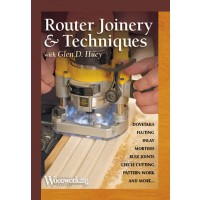We may receive a commission when you use our affiliate links. However, this does not impact our recommendations.
Why joints fail and why woodworkers fail as scientists
Whenever my late Uncle Archie came to visit, he would drive my mother crazy with where he chose to sit. He was a big man, weighing over 350 pounds and he invariably would choose a small, delicate Queen Anne reproduction from the 1890s with a needlepoint seat. Maybe he enjoyed making my mom gasp with fear or maybe he just liked sitting in a chair that he sat in as a kid. In any case, that little chair never complained, never creaked and never failed. It was made by a man who knew his trade. Luckily for the chair, my mom’s peace of mind and my uncle’s pride, the chair maker didn’t rely on information he read in a magazine somewhere.
One of the most frequent questions we are asked is what’s the best/strongest/correct joint to use in woodworking? The answer usually starts with several other questions. What’s the application? What wood? What are your skills? What tools do you have available? With those variables in mind, you can make an intelligent choice, but there will be several options that are all “more than strong enough.” It’s a multiple choice question with multiple correct answers.
Most woodworking joints have evolved over thousands of years. Woodworkers learned to make them based on their own experience, and the experience of the people who taught them. To make successful joints you need a little experience, a basic knowledge of the workings of wood and glue, and a bit of common sense. But in the 21st century we want a definitive answer. We want numbers and we want proof. We want something in writing we can point to when we’re not sure of ourselves.
Like other magazines, we have tested joints to destruction.

The last time we did it was in December 2005, and our weapon of choice was the anvil. It was a silly notion, and the point of the tomfoolery was that pseudo-scientific testing in a magazine is a rather pointless endeavor. There are so many variables in material, techniques and proportions of joints that gathering meaningful data would require thousands of samples and take months if not years to complete. If you only break a few joints, you might well be measuring the quality of the raw material, the skill of the guy who put things together, or several other variables that have nothing to do with what you want to learn.

Which doesn’t mean the anvil test was meaningless. It did show us some surprising things, notably how good today’s glues are, and how important it is to consider proportions of joints in the context of the pieces being joined. We knew going into the test that a well-made draw-bored mortise-and-tenon joint is incredibly strong, and that dowel joints almost always fail eventually. We now know a bit more about how and why and we had some fun doing it. But it bothers us when we see a test that takes itself too seriously, or when joints are labeled as “not so good” when the flaw is in the size and placement of the components, or of the wood rather than the joint.

If woodworking were more science than art, it wouldn’t be as much fun. If you want to read the “Anvil Test” click here. Keep in mind that it was written by a woodworker, not an engineer in destructive testing. It contains a lot of good information about different joints, but it doesn’t reveal which is the best/strongest/correct joint. I hope it makes you smile and make you think about how you approach the craft. That’s the whole idea.
Build strong joints with “Router Joinery & Techniques DVD” with Glen Huey at shopwoodworking.com
Here are some supplies and tools we find essential in our everyday work around the shop. We may receive a commission from sales referred by our links; however, we have carefully selected these products for their usefulness and quality.







![Tooley Park Scriber Review [Discount Week of Feb 3 2025]](https://dev.popularwoodworking.com/wp-content/uploads/bfi_thumb/dummy-transparent-olcy6s63it1p9yp7uhusjas7c8kahafrhg9su7q9i0.png)